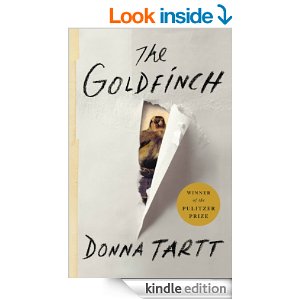I was really looking forward to reading Goldfinch. The hype around it as well as wonderful responses from my reading friends, left me anxious to read it. Often with a book that I know will be good, I save it. I always like to have a good book waiting in the wings. Did this Pulitzer-Prize-winning book measure up to the hype?
 Unfortunately I have to say it didn’t. Indeed parts of it were very good, but it certainly wasn’t a book I’d rank up there with say–Cutting for Stone by Abraham Verghese or the Dovekeepers by Alice Hoffman– a couple of my favorites. What it is that made Goldfinch a Pulitzer? I am left wondering.
Unfortunately I have to say it didn’t. Indeed parts of it were very good, but it certainly wasn’t a book I’d rank up there with say–Cutting for Stone by Abraham Verghese or the Dovekeepers by Alice Hoffman– a couple of my favorites. What it is that made Goldfinch a Pulitzer? I am left wondering.
Told from the point of view of a young boy through most of the book, the author did a nice job of putting us in his skin. The way she described his grief was absolutely on the money. Furthermore, she created a flawed character, but one with whom the reader could sympathize. I wanted Theo to be safe. I wanted him to do the right thing. Often he made poor choices, but given his circumstances, that was understandable and believable.
The subplot (if there was a plot) dealt with the painting. Perhaps that was the plot. This is where the book slows down. What was the action? Not until nearly the end of the book does action happen, and it was like a bullet being shot from a gun and going plop. For me the entire story was very slow and plodding.
This could have been a 500 page book rather than a 700+ page book. It was not redundancy that troubled me so much as asking myself, “why is this still happening.” Too often the author thinks readers don’t get it. But more often than not, we do.
I won’t say much about the symbolism of the painting in order not to give too much away. The most obvious metaphor was the chain around the bird’s talon. Theo, too, has a chain–in fact–he had several chains.
The ending wraps everything up nicely, but it goes on and on and on. My ability to skim came in very handy.
So, for this Pulitzer I would only give three stars.
If you liked this review, sign up on my site and get the first 2 chapters of The Clock Strikes Midnight. You will also get notices of contests and pre-sales.






Here was my review of The Goldfinch.
I was totally engrossed in The Goldfinch for the first third of the novel. I loved the setting, the Metropolitan Museum of Art and NYC. The plot was creative and the characters, well developed. It was exciting and addictive!
Then I spent the last three evenings reading about Las Vegas, the new setting and the alcoholic father, the low life girlfriend, and the Polish friend who constantly drank beer. It was boring. I had to stop reading at 33%. Life is too short to continue a read that doesn’t hold my interest. I am giving it three stars because of the first third.
Curl up with a killer – Cozy Mysteries
The Ginseng Conspiracy by Susan Bernhardt
Murder Under the Tree coming Fall 2014
Hi Susan. Thanks for sharing your views of Goldfinch. I thought it might just be me. Some of my friends loved it. I, too, found the Las Vegas part way too long. You actually stopped at a good place. It never got as good as the beginning. Maybe the Pulitzer people only read the first part? 🙂
I have all too often found I don’t like the Pulitzer Prize winning books or many of the NY Times Bestsellers either. For me they often share the same issues you and Susan mention. They could have been shorter and thus been better and there’s a lot of not much happening. That and I really don’t enjoy most deep-thinky type books. I read for escape, not to deal with a bunch of depressing stuff to add to what I’m already depressed about.
On the other hand, there are books I’ve read that have too much action and I end up feeling worn out after reading them – or not finishing them because the nonstop high action gets farfetched.
As in so much of life, I think the answer is balance. Finding the right amount of contemplation, action, sad moments and happy moments – some laughter and some tears. Hmm, sounds like Ecclesiastes – to every time there is a purpose – then that wonderful list of complementary opposites.
I think it’s part of why I favor cozy mysteries. 🙂
Hi Pearl, Thanks for stopping by. I agree the “thinky” books can be tedious. But. . . have you tried Dovekeepers or Cutting for Stone? Both are amazing, well-written and not tedious. I also loved Ordinary Grace and the Husband’s Secret (lighter than the first two, but very good). That’s why I can’t understand these winners of the big prizes. We, as writers, can’t get away with tedium, redundancy and poor sentence construction. Why can they? Just saying. . .
Pearl, you may enjoy my cozy mystery, The Ginseng Conspiracy. The second in A Kay Driscoll series is coming out in Fall. The novel has received great reviews on Amazon, Goodreads, etc. It was fun to write and is meatier than most cozies out there. It also deals with art and music.
Just a suggestion.
Susan